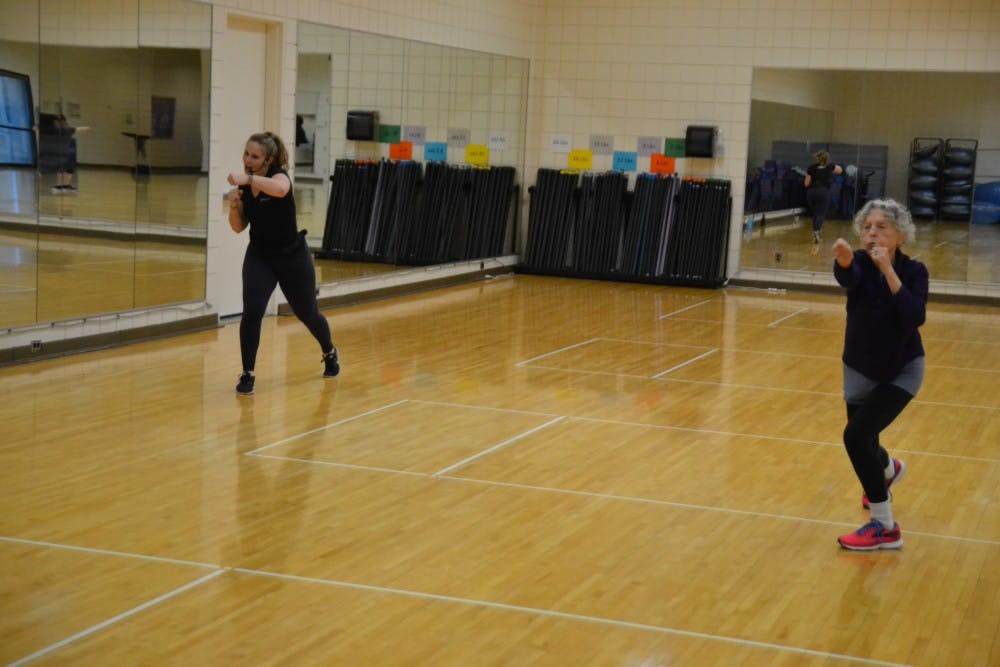Legs slowly lift a half inch above the floor as music drifts through School of Public Health room 171. Sophomore Grant Harlan and other participants slowly lift hands, legs and heads to stretch and practice yoga techniques on brightly colored mats in the dimly lit studio.
Harlan said he is also in a personal fitness class and lifts weights on the side, but he enjoys the yoga the most.
“I come here because it’s relaxing and peaceful,” Harlan said. “Out of group exercise organized like this, I like this one the most.”
Chris Arvin, program director for fitness, wellness and informal sports, said the group exercise programs focus on being available and accessible to students. Offered at the Student Recreational Sports Center and the Intramural Center, the classes span 30 minutes to an hour. They focus on certain movements and physical activity, such as cardio hip-hop or deep water exercise.
Katie Landrum, outreach and programming coordinator for recreational sports, said group exercise classes give all the benefits of typical exercise, but it can help people become more willing to exercise and keep that commitment.
“It can give people that accountability they are looking for, to be active and continually active,” Landrum said.
There are more than 80 different group exercise sessions offered at either the SRSC or the Intramural Center. Some of the different group exercise classes categories are yoga, strength and dance fitness, Landrum said.
“There’s a wide range for anybody to sign up in what they’re looking for,” Landrum said.
The group exercise classes being offered at the Intramural Center and the SRSC are a sign of the commitment to students, Arvin said.
Arvin said many students are in the heart of campus during the day. That’s where the Intramural Center comes into play, as students can exercise in between classes. Students who can drive or have the time to walk can unwind at the end of the day with exercise at the SRSC.
“Students pay a mandatory activity fee to have access to our facilities and many of our programs, and we offer those programs in two facilities on campus,” Arvin said. “That is part of the deal, that is part of the benefits.”
While intramural activities typically attract men, women tend to make up the bulk of group exercise classes attendees, Arvin said.
Arvin said he believes one of the driving factors of the gender split in group exercise classes originated from the exclusion of women in many types of sports in the late 70s and early 80s.
“Women drove this,” Arvin said. “Women were looking for a different type of opportunity to be active.”
Landrum chalked up the split up to a difference in personality rather than gender. She said people who are interested in working toward a common goal tend to gravitate toward group exercise classes and those with a competitive edge to their personality go to intramural sports.
Arvin said the variety offered at the different recreational centers is one of the best features.
“We try to be intentional about having sessions that are accessible to all fitness levels, all skill and ability levels,” Arvin said.
Anju Chandy, a yoga instructor, said she started to get into group exercise classes when she was in high school and hasn’t regretted it.
Chandy is constantly trying to invent new ways to make exercise more accessible, she said. A few of her passion projects are creating and using yoga methods for overweight women, women of color and musicians.
Yoga for musicians focuses on different stress points depending on what kind of instrument the person plays, Chandy said. In her case, as a pianist, the exercise would pinpoint stress in neck, shoulders and lower back.
“Every instrument has its own bundle of problems and how it affects the body,” Chandy said.
Chandy said accessibility is one of the things she strives for. She said many people who can benefit or reap the rewards from yoga are the ones who are the least likely to access it, whether the barrier be time or finances.
“The people who need yoga the most are not always the ones who can afford it,” Chandy said.
CORRECTION: A previous headline for this story misstated the name of the Intramural Center, calling it the WIC. The WIC was renamed the Intramural Center in October. The IDS regrets this error.




